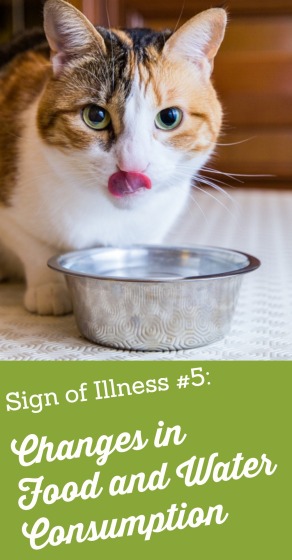The fifth subtle sign of illness in cats is changes in their food or water consumption. As with sleep, this refers not just to quantity, but also behaviors associated with eating and drinking.
Where does your cat prefer to eat or drink? Cats with arthritic pain may no longer be able to jump up onto counters or cat perches to eat and drink. Cats with vision loss may not be able to find food or water bowls and prefer to have the bowls brought to them. Fearful or painful cats may wish to eat alone and not with other cats. Cats with diseases that cause an increase in water intake, such as kidney disease or diabetes, may all of a sudden want to drink water from the faucet, from your glass, or out of the toilet or bathtub.
How often does your cat eat or drink? Cats are grazers by nature. They prefer several small meals throughout the day. Cats with diabetes or hyperthyroidism may request to eat more frequently. Cats with dental pain, intestinal disease, irritable bowel syndrome, kidney disease or cancer may only eat once a day.
How much is your cat eating or drinking at each time? Cats with hyperthyroidism, diabetes, intestinal parasites and maldigestive disorders tend to eat large quantities and drink large quantities. Cats with kidney disease often drink large amounts of water, but have poor appetites. Fearful cats may eat large quantities quickly to avoid coming into contact with bully cats. Cats with dental disease or nausea may only eat and drink small amounts at one time.
What is your cat’s body posture during eating? Cats with dental disease may move food to one side of the mouth or tilt their head while eating. Cats with orthopedic disease, neurologic disease, diabetes or kidney disease may prefer to lie down while eating or drinking. Cats with vision or sensation losses may use their paws to bring water from the water bowl to their mouth.
Every cat has his own particular preferences in how much, how often and where to eat, but the key to detecting disease is to look for changes in your cat’s normal eating and drinking routine. Any change in routine should be addressed with your veterinarian.
Next week’s topic for signs of illness in cats is unexplained weight loss or weight gain.

